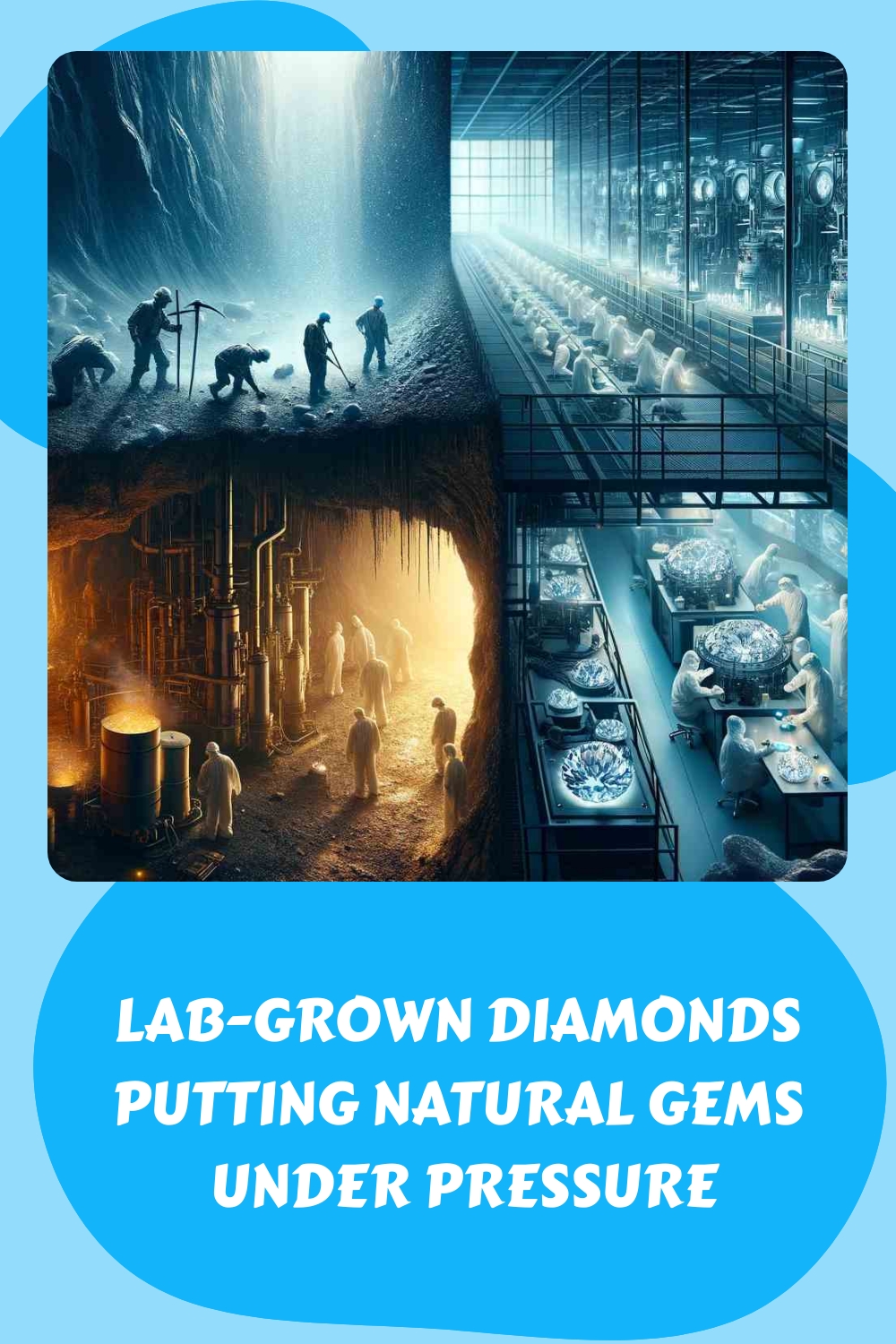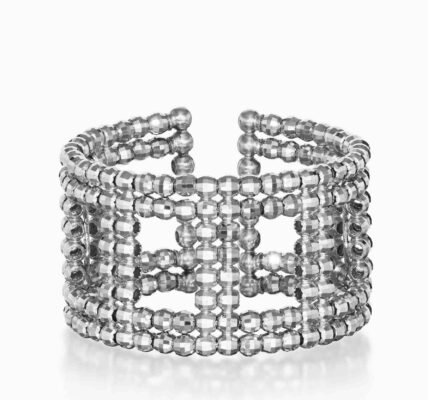The glittering diamonds sparkle the same but there are key differences: mined natural gems are more than a billion years old, while laboratory-made rocks are new and cost less than half the price. Recent changes in the diamond industry are putting natural gems under pressure like never before.
Article Contents
TL;DR Natural Gems Under Pressure
Lab-grown diamonds offer a more cost-effective and eco-friendly alternative to traditional mined diamonds. The market for lab-grown diamonds is expanding, and consumers are increasingly opting for them, especially for engagement rings.
Man-made Gems are Reshaping the $89 Billion Global Diamond Jewellery Market
Man-made or lab-grown gems have been making significant strides in reshaping the global diamond jewellery market. With advancements in technology and growing consumer awareness, lab-grown diamonds have emerged as a formidable competitor to natural diamonds. Let’s delve into some key points that highlight the impact of man-made gems on the industry:
Tripled Value of Lab-Grown Diamond Exports
One of the most noteworthy trends in the market is the staggering increase in the value of lab-grown diamond exports from India between 2019 and 2022. The export value of these gems tripled during this period, showcasing a growing demand for sustainable and ethically sourced alternatives to traditional diamonds.
25% Increase in Export Volumes
Another significant indication of the rising popularity of lab-grown diamonds is the 25% increase in export volumes recorded between April and October 2023. This surge in demand underscores the shifting preferences of consumers towards environmentally conscious and socially responsible jewellery options.
Lab-grown gems have now captured a substantial market share, accounting for 18.5% of the global diamond jewellery market. This growth trajectory is a clear reflection of the changing dynamics within the industry, with more consumers opting for lab-grown diamonds due to their identical physical, chemical, and optical properties to natural diamonds.
In conclusion, the rise of man-made gems is revolutionizing the diamond jewellery market by offering sustainable, conflict-free, and cost-effective alternatives to traditional diamonds. As technology continues to advance and consumer preferences evolve, lab-grown diamonds are poised to play an even more significant role in shaping the future of the industry.
Reactor Technology and Clean Record Attract Customers
Lab-grown diamonds have been gaining significant traction in the jewelry industry in recent years, largely due to the innovative use of reactor technology in their production. These diamonds are created in specialized facilities that replicate the extreme pressure and conditions found deep underground where natural diamonds are formed. The use of reactors not only allows for the controlled growth of diamonds but also offers a more sustainable and ethical alternative to traditional mining practices.
Lab-Grown Diamonds and Reactor Technology
Unlike natural diamonds that are mined from the earth, lab-grown diamonds are cultivated in controlled environments using advanced reactor technology. These reactors mimic the geological processes that occur over millions of years underground, compressing carbon atoms to form diamond crystals. By harnessing this technology, manufacturers can produce high-quality diamonds with the same chemical composition and physical properties as natural diamonds.
One of the key advantages of reactor technology is the ability to create diamonds of varying sizes, shapes, and colors with precision and consistency. This level of control enables producers to meet the specific demands of customers and offer a wide range of options in the market. Additionally, the efficiency of reactor-based production results in a shorter turnaround time compared to the lengthy process of mining and extracting natural diamonds.
Environmental and Ethical Considerations
Lab-grown diamond producers take pride in the sustainable and ethical practices employed in their facilities. Unlike traditional mining operations that can have detrimental environmental impacts, lab-grown diamonds offer a more eco-friendly alternative. By reducing the need for large-scale mining activities, these synthetic diamonds contribute to lower carbon emissions and less disruption to natural ecosystems.
Furthermore, the ethical aspect of lab-grown diamonds cannot be overlooked. The transparency and traceability of these diamonds from the laboratory to the consumer ensure that they are free from the controversies often associated with the diamond mining industry. Customers are increasingly drawn to the clean record and responsible sourcing practices of lab-grown diamonds, making them a preferred choice for those who prioritize ethics and sustainability.
Rising Popularity in Engagement Rings
One notable trend in the jewelry market is the growing popularity of lab-grown diamonds in engagement rings. Couples are increasingly choosing these synthetic diamonds for their special occasions due to their exceptional quality and meaningful origins. The affordability of lab-grown diamonds compared to natural counterparts also makes them an attractive option for those seeking a stunning yet cost-effective ring.
Moreover, the versatility of lab-grown diamonds allows for creative designs and customization, giving couples the opportunity to personalize their rings according to their preferences. Whether it’s a classic solitaire or a unique halo setting, lab-grown diamonds offer endless possibilities for creating the perfect symbol of love and commitment.
In summary, the use of reactor technology in producing lab-grown diamonds has revolutionized the jewelry industry by offering a sustainable, ethical, and high-quality alternative to mined gems. The clean record and environmental benefits of lab-grown diamonds, coupled with their increasing popularity in engagement rings, reflect a shifting consumer preference towards more responsible and innovative choices in the world of fine jewelry.
Challenges and Falling Prices
The diamond industry is experiencing a significant shift with the rise of lab-grown diamonds. One of the key challenges posed by this trend is the plummeting prices of lab-grown diamonds. The supply of these man-made gems has skyrocketed, causing a drastic drop in their wholesale prices. In the year 2023 alone, the wholesale prices of lab-grown diamonds decreased by a staggering 58 percent. This rapid decline in prices has sparked discussions and debates within the industry about the future of lab-grown diamonds and their impact on the market.
Supply Surge and Price Drops
The surge in the supply of lab-grown diamonds can be attributed to advancements in technology that have made the production of these diamonds more efficient and cost-effective. Lab-grown diamonds are created in controlled environments that mimic the natural processes that occur in the Earth’s mantle, where natural diamonds are formed. This method of production not only allows for a more sustainable and eco-friendly alternative to mined diamonds but also significantly reduces the overall cost of manufacturing.
As a result of this increased supply and more streamlined production processes, the prices of lab-grown diamonds have experienced a sharp decline. This trend has been particularly pronounced in the wholesale market, where industry players have witnessed a substantial decrease in the cost of acquiring lab-grown diamonds. The accessibility and affordability of these man-made gems have reshaped the diamond market landscape and challenged traditional norms within the industry.
Impact on the Industry
The falling prices of lab-grown diamonds are expected to have a profound impact on the diamond industry as a whole. While natural diamonds have long been coveted for their rarity and value, the advent of lab-grown diamonds has introduced a new dimension to the market. Consumers now have a wider range of options to choose from, with lab-grown diamonds offering a more affordable alternative to their natural counterparts.
Additionally, the decreasing prices of lab-grown diamonds are likely to spur demand for these man-made gems. As more consumers become aware of the ethical and environmental benefits of lab-grown diamonds, there is a growing interest in incorporating these stones into jewelry pieces. The affordability of lab-grown diamonds also makes them an attractive option for buyers who are looking for high-quality diamonds at a lower price point.
Future Prospects
Looking ahead, the future of lab-grown diamonds seems promising yet uncertain. While the falling prices of these diamonds have made them more accessible to a wider audience, there are still challenges that need to be addressed. One of the key issues facing the lab-grown diamond industry is consumer perception and education. Many buyers are still unaware of the differences between natural and lab-grown diamonds, leading to misconceptions and misunderstandings about the value and authenticity of these gems.
However, as awareness and acceptance of lab-grown diamonds continue to grow, the market for these man-made gems is expected to expand. The affordability and sustainability of lab-grown diamonds make them an appealing choice for environmentally-conscious consumers and those seeking high-quality diamonds at a lower price. With the right efforts in marketing, education, and transparency, lab-grown diamonds have the potential to revolutionize the diamond industry and offer a viable alternative to traditional mined diamonds.
Impact on the Natural Diamond Industry
Natural diamond companies in India have recently experienced a significant impact on their operations, with reports indicating a more than 25 percent drop in sales. This downturn can be attributed to various factors, including the effects of slowing economic growth and an oversupply of diamonds in the market. Additionally, the Indian natural diamond industry has taken proactive measures to address these challenges, such as implementing a voluntary import ban on rough diamonds.
Slowing Economic Growth
One of the key factors contributing to the decline in sales for natural diamond companies in India is the overall slowdown in economic growth. As global economic conditions have become more challenging, consumer demand for luxury goods like diamonds has weakened. This has put pressure on diamond producers, leading to a decrease in sales and revenues.
Oversupply of Diamonds
Another significant issue facing the natural diamond industry is the oversupply of diamonds in the market. In recent years, diamond production has increased significantly, leading to a surplus of diamonds available for sale. This oversupply has driven down prices and made it more difficult for diamond companies to maintain profitability.
Voluntary Import Ban
In response to these challenges, the Indian natural diamond industry has taken proactive steps to mitigate the impact of the economic slowdown and oversupply. One of the most notable measures implemented is a voluntary import ban on rough diamonds. By restricting the inflow of rough diamonds into the country, diamond companies aim to stabilize prices and reduce the oversupply in the market.
This voluntary import ban demonstrates the industry’s commitment to addressing the current challenges and ensuring the long-term sustainability of the natural diamond sector in India. By taking decisive action, diamond companies seek to protect their interests and maintain a competitive edge in the global market.
In conclusion, the impact on the natural diamond industry in India is a complex issue driven by a combination of factors, such as slowing economic growth and oversupply. Despite these challenges, industry players are working diligently to navigate the current landscape and position themselves for future success.
Conclusion and A Look to a Bright Future
Lab-grown diamonds have emerged as a compelling alternative to traditional mined diamonds in recent years. Offering a more affordable and environmentally friendly option, lab-grown diamonds are gaining traction not only in the jewelry industry but also among consumers who prioritize sustainability and cost-effectiveness.
The increasing market share of lab-grown diamonds is a testament to their growing popularity and acceptance. As technology advances and production processes become more efficient, the availability and quality of lab-grown diamonds are expected to improve further, making them an even more viable choice for consumers.
One of the key driving factors behind the shift towards lab-grown diamonds is customers’ changing preferences, especially when it comes to engagement rings. More and more couples are opting for lab-grown diamonds due to their ethical and environmental considerations, as well as their attractive pricing compared to mined diamonds.
Overall, the future looks bright for lab-grown diamonds, with their appeal likely to continue rising in the coming years. As awareness grows and more consumers recognize the benefits of choosing lab-grown diamonds, the demand for these sustainable and affordable gems is only expected to increase. This evolution of diamonds, from traditional mined gems to lab-grown alternatives, reflects a significant shift in the jewelry industry. With advancements in technology and manufacturing, lab-grown diamonds are now nearly indistinguishable from their naturally occurring counterparts, making them an attractive option for consumers. As more people embrace the ethical and environmental benefits of lab-grown diamonds, their popularity and market share are likely to continue expanding.
Further Reading About this Topic
1: https://www.france24.com/en/live-news/20240220-lab-grown-diamonds-put-natural-gems-under-pressure
2: https://phys.org/news/2024-02-lab-grown-diamonds-natural-gems.html
3: https://www.gemsociety.org/article/sustainable-alternative-to-diamond-mining/
4: https://www.vogue.co.uk/fashion/article/lab-grown-diamond-engagement-ring
6: https://medium.com/@patil.rockstars/lab-grown-diamonds-a-sustainable-sparkle-revolution-205ffa6dc637
7: https://www.technopak.com/lab-grown-diamonds-the-sparkling-revolution-in-indias-diamond-industry/






